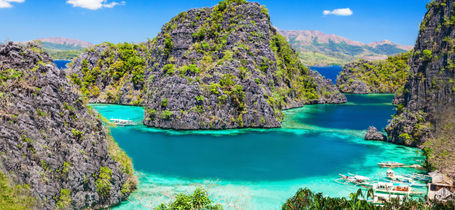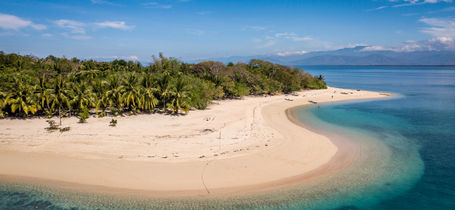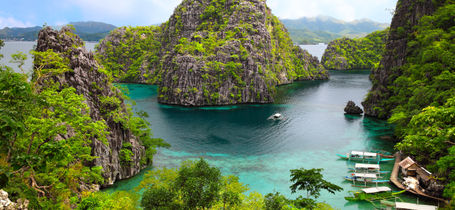Puerto Galera Diving
The sheltered coves of Puerto Galera on the northern edge of Oriental Mindoro Island are famous as a dive destination. Its location at the centre of the coral triangle means the reefs you find here are diverse and stunning. They host schooling fish, macro critters and pelagic life. With plenty of dive resorts and dive sites suited to all levels, everyone will find something to love here.
Diving in Puerto Galera
Puerto Galera is one of the most popular dive destinations in the Philippines. Its location on northern Mindoro makes it super convenient for short trips from Manila, only 130km to the north. It not only has amazing reefs to enjoy but also a bustling tourist social scene.
This area was designated as a Biosphere Reserve of UNESCO in 1973. The coral reefs have benefited from the reduction in fishing activities and they’re some of the healthiest in the world. The marine diversity is high, with 180+ species of nudibranch alone found in these waters, as well as three different kinds of endangered turtles.
White Beach is listed routinely as one of the most beautiful bays in the world because of its pristine sands. The majority of dive sites (and dive centres/resorts) are located around Sabang Beach, on the outcrop of Sinandigan, around 12km west of White Beach. Big La Laguna Beach and Small La Laguna Beach are on Sabang, surrounded by dive resorts. There is certainly no shortage here!
The many dive centres and resorts here can provide dive courses with any of the major dive federations, depending on the shop. PADI, SSI, NAUI, CMAS and TDI are all represented here. It is not only a popular place for its beginner courses, but for all courses up to technical diving and professional qualifications. The 40+ dive sites will keep everyone happy with a variety of reefs, walls, wrecks, muck and drift diving, including the nearby Verde Island. A few liveaboards in the area are another option for those who wish to maximise their time on the oceans.
Best time to dive
Diving in Puerto Galera is possible year-round due to its warm, tropical climate. It is also surrounded by mountains and islands which protect it from the worst of the monsoon season - though there is still a wet and dry season.
The dry season runs from December - May, with minimal rainfall and calm winds during this time. December - February are the coldest months of the year, with water temperatures sometimes dropping as low as 23oC below the thermocline. Conversely, April - June tend to be the warmest months of the year. This is considered to be the high season, with the most tourists. Around big holidays like New Year and Easter, bear in mind that resorts may fill up far in advance.
The rainy season runs from June - November. Though rainfall tends to be higher and the winds stronger, this is often a perfect time to dive. The water is warm, the visibility can be fantastic and you can be lucky with the weather. Another benefit is that the rates of some hotels decrease. The downside is that occasionally boats will be cancelled due to bad weather.
Types of diving
The most famous diving in Puerto Galera is the reef diving. The gardens here are home to over 300 species of corals, as well as almost 60% of earth’s shore fish species. Night diving on these reefs, particularly around Sabang, is excellent. Muck diving lovers will love exploring the ocean floor as the night time beasties start to come out. The macro life is incredible. One highlight is found at Monkey Beach dive site with multiple pygmy seahorses found on one sea fan.
There are plenty of drift dives here, many of which are fast and strong. Some dive sites have up and down currents to contend with too - not for the faint-hearted or the inexperienced! There are a few caves and swim-throughs, such as the one at Hole in the Wall at 12m. There are also wrecks like the Sabang Wrecks and the Alma Jane to explore.
The wall dives found here are some of the best. Sites such as The Drop Off on Verde Island and Senandigan Wall offer dramatic descents into deep water which may be intimidating for a newbie diver. These walls are very popular with technical divers too due to the depth.
Liveaboard diving is popular in this area as there are so many dive sites. Particularly around Verde Island, you would find yourself doing multiple day trips from Puerto Galera if you wish to do more than a couple of dives. Therefore, liveaboards can be an efficient way of diving everywhere you wish to.
What to see
The corals in Puerto Galera are some of the healthiest in the world. There was a severe coral bleaching event in 1998 but they have bounced back with even greater diversity. Luckily the 2010 El Niño event left the coral gardens here largely unscathed. Its status as a marine protected area, with heavy restrictions on fishing, help to protect the corals further.
Healthy reefs mean healthy reef life. Schools of fish swarm at most dive sites - fusiliers, mackerel, moorish idols, batfish, snappers, jacks, trevally, basslets and barracuda are all common sights. Colourful reef fish like triggerfish, parrotfish, lionfish, wrasse, anemonefish, butterflyfish and angelfish are numerous.
Cephalopod lovers will be delighted at the variety; cuttlefish, squid and octopus - including the super rare blue-ringed, mototi, mimic and wonderpus varieties. Hiding in the nooks and crannies, you will find moray eels and reef sharks. Other hidden beasties include ribbon eels, frogfish, mantis shrimp, scorpionfish, leaf fish, pipefish, rhinopias, lobsters, crabs, shrimps and nudibranch in their hundreds. You might spot a black and white banded sea snake undulating through the water. If you are a photographer, the diving in Puerto Galera will quickly fill your camera reel.
Fans of larger life forms while diving will not be disappointed either. Turtles like hawksbills, green and olive ridleys are seen all over. Humphead wrasses are visible, particularly around the full moon. Verde Island has deep water and strong currents. The fast flowing water attracts big trevally and tuna, as well as occasional visits from eagle rays, marble rays, manta rays, thresher sharks, hammerhead sharks and even the occasional whale shark has been spotted here.
Best places to dive
Canyons - A favourite among advanced divers, this site has a maximum depth of 32m and is made up of three deep canyons. Turtles, reef sharks and octopus as well as schooling trevally, tuna and barracuda make this site unforgettable. There is often a strong drift.
Fish Bowl - Necessitating a blue water descent down to the “bowl” at 40m, this site requires experienced divers. The watchword here is quantity - shoals of tuna, barracuda and jacks and sharks - sometimes even hammerheads.
Verde Island - These sites require a day trip from Puerto Galera but it’s worth it. It is perfect for technical divers due to the deep walls but it can be dived by advanced divers too. The visibility here usually exceeds 30m, but you definitely won’t see the bottom-most dive sites drop into 80m+ water. The Wall and San Agapito Point offer excellent corals and adrenaline junkies will love “The Washing Machine” for its wild currents.
Sabang Wrecks consist of three purposefully sunken wrecks which now act as artificial reefs, hosting schools of fish. With a max depth of 21m, this site is perfect for a first time wreck diver.
West Escarceo - As this site is a sloping reef, down to 35m, this site can be catered for all levels. Swarms of red tooth triggerfish dot the blue ocean, moray eels, whitetip reef sharks and turtles live on the reef and the sandy bottom at 35m has lots of blue spotted stingrays. Sinandigan Wall is a macro photographers dream, with nudibranch galore. This wall has a 30m max depth, and every cm of that is covered in stunning corals. Turtles and macro life alike enjoy the abundance found here.


